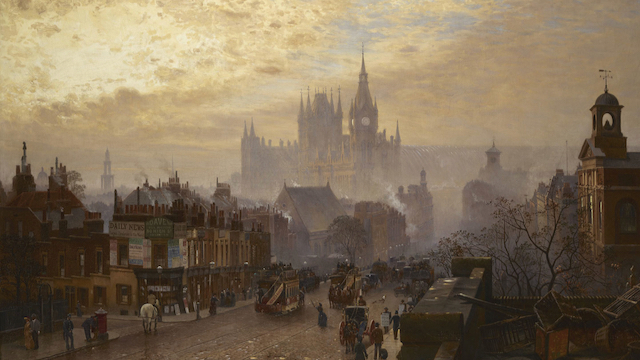“It is too little to say William Gillette resembled Sherlock Holmes. Sherlock Holmes looks exactly like William Gillette.” (Orson Welles, Mercury Theatre on the Air, 25 September 1938)

William Hooker Gillette was born on July 24, 1853, in Hartford, Connecticut. He played Sherlock Holmes on stage for the first time in 1899, and is inextricably linked to the role in the minds of many fans, having performed it more than 1300 times. He appeared in a 1916 film based on the play he wrote – a film thought long-lost until a copy was discovered in the Cinémathèque Française archive in 2014. The restored film was featured at film festivals and released on DVD in 2015.
(Ariana Maher (JHWS “Carla”) recounts her trip to see it at the Seattle International Film Festival in “A Day at the Movies“.)
The four-act play took elements from “A Scandal in Bohemia” and “The Final Problem”, as well as A Study in Scarlet, The Sign of Four, “The Boscombe Valley Mystery”, and “The Greek Interpreter”. Other than Holmes, Watson, and Moriarty, the characters were Gillette’s inventions. Those include Alice Faulkner – Holmes’s client and eventual romantic interest – and Billy the Pageboy, before his appearance in “The Adventure of the Mazarin Stone”.

Gillette’s portrayal of Holmes shaped the American image of the Great Detective. The curved pipe (which was better for being understood on stage) and the deerstalker cap (taken from Paget’s illustrations) became permanent accessories. Frederic Dorr Steele’s illustrations of Holmes for Collier’s Weekly seem to take Gillette as a model.
Between 1914 and 1919, Gillette designed and had constructed an elaborate home in East Haddam, CT. Upon his death in 1937, his will instructed that his home should not be allowed to go to “some blithering saphead who has no conception of where he is or with what surrounded.” The property was purchased by the State of Connecticut in 1943 and is now known as Gillette Castle State Park.
Sources: A Curious Collection of Dates: Through the Year with Sherlock Holmes, by Leah Guinn (JHWS “Amber”) and Jaime N Mahoney (JHWS “Tressa”); The Sherlock Holmes Miscellany, by Roger Johnson (JHWS “Count”) and Jean Upton (JHWS “Countess”); Kevin Noonan, “Lost ‘Sherlock Holmes’ Film Discovered After Almost a Century” (Variety.com); and IMDb.

 For generations of Sherlockian devotees around the world, Basil Rathbone was known as Sherlock Holmes. He portrayed the detective in two movies produced by Twentieth Century Fox and set in the Victorian era:
For generations of Sherlockian devotees around the world, Basil Rathbone was known as Sherlock Holmes. He portrayed the detective in two movies produced by Twentieth Century Fox and set in the Victorian era:  Rathbone and his Watson from both films, Nigel Bruce, went on to feature in twelve films produced by Universal Studios that brought the characters forward in time to fight Nazis during World War II, among other adventures. With those films, fans of a generation learned of Sherlock Holmes. The films have morphed into a television event that can still be seen today. Thank Goodness for the chance to watch and re-watch these films.
Rathbone and his Watson from both films, Nigel Bruce, went on to feature in twelve films produced by Universal Studios that brought the characters forward in time to fight Nazis during World War II, among other adventures. With those films, fans of a generation learned of Sherlock Holmes. The films have morphed into a television event that can still be seen today. Thank Goodness for the chance to watch and re-watch these films.
















 On July 8, 1837, Mary Josephine Foley was born. She grew up with a strong role model in her mother, Catherine Pack Foley, who supported her young family after being widowed when Mary was three. Catherine taught in Ireland and in Edinburgh, where she also opened a governess placement service. [Shades of Miss Violet Hunter in COPP –Chips]
On July 8, 1837, Mary Josephine Foley was born. She grew up with a strong role model in her mother, Catherine Pack Foley, who supported her young family after being widowed when Mary was three. Catherine taught in Ireland and in Edinburgh, where she also opened a governess placement service. [Shades of Miss Violet Hunter in COPP –Chips]